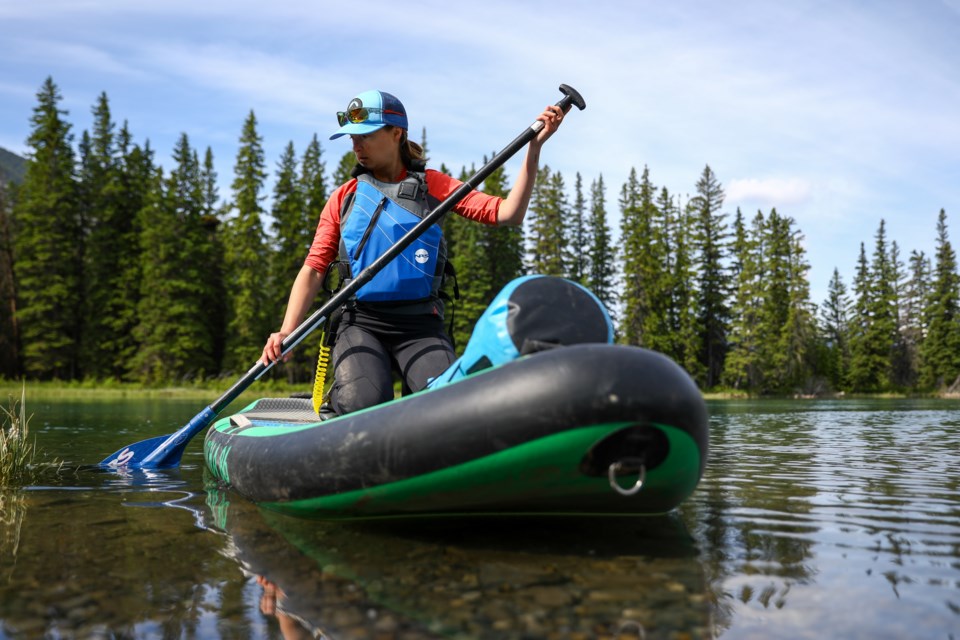Offering some of Banff National Park's most stunning scenery, the aura of the light-blue lakes and rivers attract tens of thousands of visitors and locals every year wanting to experience the park in a fun new way.
But for the water-enthusiast-in-the-making, a lack of experience and improper use of equipment and watercrafts can turn a special day into a total disaster.
Before setting out, here are water safety tips on rivers and lakes in Banff National Park.
Don’t underestimate rivers
Banff's most famous river, the Bow River, is a cold glacier-fed watercourse with every hazard associated with a fast-flowing river such as sweepers, log jams and quick-moving waters.
Parks Canada typically responds to a dozen water rescues per year on the snaking section of the Bow River flowing through Banff National Park, noting a lack of understanding and respect for the river in the Rocky Mountain wilderness, said visitor safety specialist Brian Webster.
“If somebody had very little or no experience paddling swift-moving water, I wouldn’t advise them to go on the Bow River,” said Webster.
"Often people come from different parts of Canada or different parts of the world where the water is warm and their experience is their benign rivers and you can launch an inflatable raft or beach toy and float lazily down the river on a nice hot day ... but it doesn't take long before you go around the first corner and suddenly there’s hazards associated with a swift-moving river such as the Bow River."
The river's chilly water doesn’t normally raise above 10 Celsius, which can be deadly if you fall in.
“Even on the warmest summer day the water is going to be cold and if you spend any amount of time in the river you will get cold and if you’re in there for a longer period of time you’ll get hypothermic,” Webster said.
Always use appropriate equipment and watercrafts
No one should go on the Bow River with "glorified toys" like Parks Canada has seen far too many people using every year.
“Often we see people get into trouble using an inflatable raft that’s designed and suitable for a beach – they’re not suitable for a river. They just drift where the currents going and they will always go into the hazards,” said Webster.
"Whatever the craft is you’re using, it should be designed for the river and you should know how to use it."
Before launching from shore to water, one should always remember that a personal floatation device or life jacket is not only a legal requirement to wear, but also the smart choice.
Webster also recommends bringing along a water-tight bag for cell phones, car keys, dry clothes, and wallets.
“We’ve picked up many people who have lost everything; they’ve lost their car keys, they’ve lost their wallet, they don’t have a cell phone, so they're relying on a passerby for help," he said.
What should I do if I fall into the water?
If an unplanned dip should occur into the biting glacial waters, the top priority is to get out, said Webster.
In such cases, wearing a life jacket is crucial as the initial shock of being dunked in glacier-fed water can take your breath away for a few seconds and seize up your body.
"If you have a life jacket, you will float, so even though you're cold and in shock, you won’t sink and you can start doing your best to make your way to shore," said Webster.
But once on shore, being stranded is a possibility one has to be prepared for.
"Every situation is different, but certainly if you have a communication device, and if you feel you need help, you can call for help," Webster said, adding to call 911, who'll redirect the caller to visitor safety specialists.
"When we speak to people, we might be able to tell them how to help themselves."
For those without use of a communication device, they might have to wait for someone on the river who can call for help for them.
Inexperienced water users should recreate on calm lakes instead of rivers
Calm lakes, namely the popular Two Jack Lake and Johnson Lake, are better suited for beginner water enthusiasts in Banff National Park.
Seek advice before setting out
Ask advice of someone experienced or go online and research locations or routes. Remember, before setting out, let someone you trust know where you're going and when you’re due back.
Never mix alcohol/drugs and boating
It's against the law for people to drive a boat under the influence of alcohol or drugs in Alberta. A person will face the same fines and penalties as it is for doing so with a vehicle under the Criminal Code of Canada.
What watercraft rental options are available in Banff?
The Banff Canoe Club rents out canoes, kayaks and stand up paddleboards to visitors and locals.
Located on corner of Bow Ave. and Wolf St., recreationalists of all levels can cast off the club's docks onto a flat point on Bow River in the appropriate river crafts.
“We get a lot of first timers so we offer a far bit of instruction in the basics of canoeing or kayaking and paddleboarding," said Daryn McCutcheon, owner of Banff Canoe Club.
"At the end of the day, it's a very peaceful way to spend a couple hours, to see the sights, and it's very popular and I highly recommend it."




